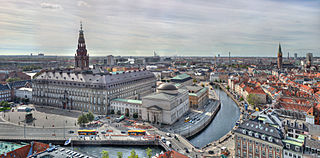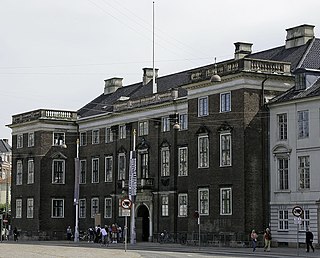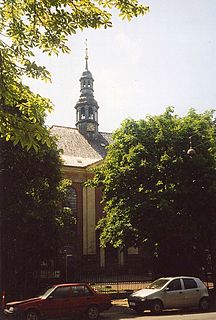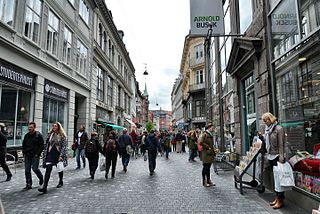
Copenhagen is the capital and most populous city of Denmark. As of 1 January 2021, the city had a population of 799,033. It forms the core of the wider urban area of Copenhagen and the Copenhagen metropolitan area. Copenhagen is situated on the eastern coast of the island of Zealand; another portion of the city is located on Amager, and it is separated from Malmö, Sweden, by the strait of Øresund. The Øresund Bridge connects the two cities by rail and road.

Frederick IV was the king of Denmark and Norway from 1699 until his death. Frederick was the son of Christian V of Denmark-Norway and his consort Charlotte Amalie of Hesse-Kassel.

Frederiksborg Castle is a palatial complex in Hillerød, Denmark. It was built as a royal residence for King Christian IV of Denmark-Norway in the early 17th century, replacing an older castle acquired by Frederick II and becoming the largest Renaissance residence in Scandinavia. On three islets in the Slotssøen, it is adjoined by a large formal garden in the Baroque style.

Copenhagen Central Station is the main railway station in Copenhagen, Denmark, and the largest railway station in Denmark. With more than 100,000 travelers every day, it is the second busiest station in Denmark after Nørreport station. It is located in central Copenhagen, situated between the districts of Indre By and Vesterbro with entrances from Bernstorffsgade, Banegårdspladsen, Reventlowsgade and access to platforms from Tietgensgade.

Kongens Nytorv is a public square in Copenhagen, Denmark, centrally located at the end of the pedestrian street Strøget. The largest square of the city, it was laid out by Christian V in 1670 in connection with a major extension of the fortified city, and has an equestrian statue of him at its centre. The initiative moved the centre of the city from the medieval area around Gammeltorv, at that time a muddy medieval marketplace, to a cobbled new square with a garden complex, inspired by the Royal city planning seen in Paris from the early 17th century.

Cobe is a Copenhagen-based architectural firm owned and managed by architect Dan Stubbergaard. As of 2020, the office has 150 employees and is involved in a large number of projects throughout Europe and North America within urban planning, architecture, landscape architecture and interior design.

Charlottenborg Palace is a large town mansion located on the corner of Kongens Nytorv and Nyhavn in Copenhagen, Denmark. Originally built as a residence for Ulrik Frederik Gyldenløve, it has served as the base of the Royal Danish Academy of Fine Arts since its foundation in 1754. Today it also houses Kunsthal Charlottenborg, an institution for contemporary art, and Danmarks Kunstbibliotek, the Royal Art Library.

The architecture of Denmark has its origins in the Viking period, richly revealed by archaeological finds. It became firmly established in the Middle Ages when first Romanesque, then Gothic churches and cathedrals sprang up throughout the country. It was during this period that, in a country with little access to stone, brick became the construction material of choice, not just for churches but also for fortifications and castles.

The French Embassy in Copenhagen is the main diplomatic mission of France to the Kingdom of Denmark. It is located in the Thott Palace at Kongens Nytorv 4 in central Copenhagen, Denmark. The ambassador since July 6, 2018 is Caroline Ferrari, in replacement of François Zimeray.

The fortifications of Copenhagen underwent a comprehensive modernization and expansion in the 17th century. The project was commenced and was largely the masterplan of Christian IV in the early 17th century but was continued and completed by his successors. The new fortifications relied on the existing, medieval fortifications of the city but the fortified area was extended and a defensive ring around the city completed particularly with new edifices facing the sea. The ring fortification consisted of four bastioned ramparts and an annexed citadel as well as various outworks.

Den Danske Vitruvius is a richly illustrated 18th-century architectural work on Danish monumental buildings of the period, written by the Danish Baroque architect Lauritz de Thurah. It was commissioned by Christian V in 1735 and published in two volumes between 1746 and 1749. The title refers to the Roman architect and engineer Vitruvius, who published De architectura in the 1st century AD, an authoritative treatise on the architecture of the time. The direct inspiration for de Thurah's Den Danske Vitruvius was Colen Campbell's Vitruvius Britannicus.

Ewert Janssen or Evert Janssen was a Danish architect who became a royal masterbuilder in 1668. His greatest achievement was Charlottenborg Palace in Copenhagen.
Hans van Steenwinckel the Youngest (1639–1700) was a Danish architect and sculptor, son of Hans van Steenwinckel the Younger and grandson of Hans van Steenwinckel the Elder. Following in the footsteps of his father and grandfather, he became a Royal Building Master in 1669. Around 1680 he also became Naval Building Master at Holmen, replacing Ewert Janssen.

Reformed Church in Gothersgade, opposite Rosenborg Castle, is a church building used by the reformed congregations in Copenhagen, Denmark. Consecrated in 1689, the church was instigated by Queen Charlotte Amalie, consort of King Christian V, who was herself a German Calvinist. The church is noted for its fine Baroque interiors which date from 1730 when it was restored after being damaged in the Copenhagen Fire of 1728.

Nørre Voldgade is a street in central Copenhagen, Denmark. It runs north-east from Jarmers Plads for approximately 600 metres to Gothersgade where it turns into Øster Voldgade. The succession of Nørre Voldgade, Øster Voldgade and Vester Voldgade together forms a traffic artery which arches around the Zealand side of the central and oldest part of Copenhagen. Nørreport Station, Denmark's busiest railway station, is located in the street.
Events from the year 1671 in Denmark.

The Thott Mansion is a listed town mansion located on Kongens Nytorv in Copenhagen, Denmark. It was built for the naval officer Niels Juel in the 1680s but his Baroque mansion was later adapted to the Neoclassical style by the French architect Nicolas-Henri Jardin in 1763. The building takes its current name after the Thott family who owned it from 1750 to 1930. It now houses the French embassy.

Købmagergade is a pedestrian shopping street in the Old Town of Copenhagen, Denmark. It connects Amagertorv on Strøget to Nørreport station, although the last section, north of Kultorvet, is part of Frederiksborggade, which continues on the other side of the railway station.

Kultorvet is a public square in the Old Town of Copenhagen, Denmark. Together with Købmagergade and the southern part of Frederiksborggade, it forms a pedestrian zone between Nørreport station and Amagertorv on Strøget. The square is lined with cafés and shops and is a popular venue for outdoor concerts in the summer time. Copenhagen Central Library was from the 1950s based on the square but has now relocated to a building in Krystalgade. Its old building has now been taken over by Niels Brock Copenhagen Business College.

Frederiksborggade is a street in central Copenhagen, Denmark. It runs from Kultorvet square in the southeast to Søtorvet where Queen Louise's Bridge connects it to Nørrebrogade in Nørrebro on the other side of The Lakes. The street is effectively divided in two by Nørreport station on Nørre Voldgade. The short, southern portion, together with Kultorvet and Købmagergade, forms a pedestrian zone between the station and Strøget at Amagertorv. The wider and younger northern portion is open to car traffic.


















